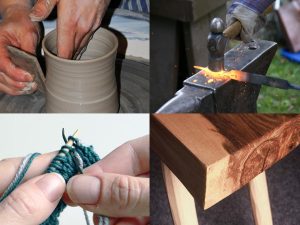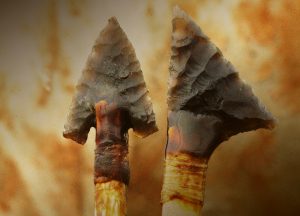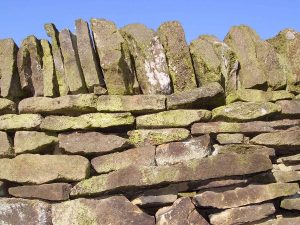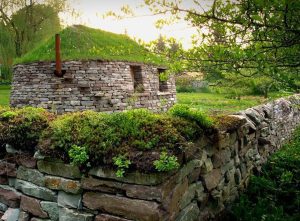Stone carving - introduction
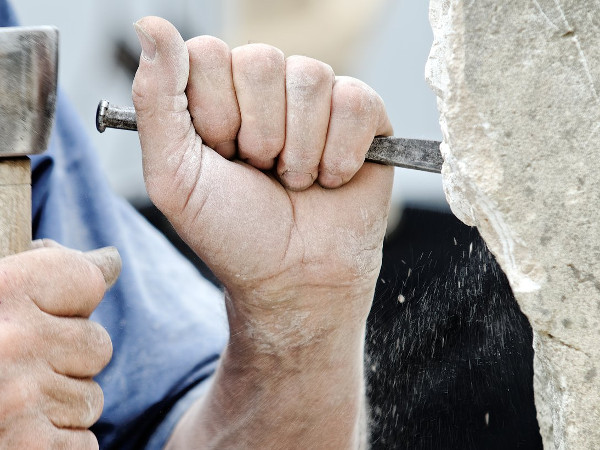
“Working the surface of a stone is an attempt to understand the internal energy of the stone.” – Andy Goldsworthy
Contents
What is stone carving?
It’s working stone as a craft or as an art, in three main areas:
- Traditional masonry work – cutting regular blocks and making repairs to stone buildings; blocks can be squared or carved into arches, foliage etc., notably on old churches and cathedrals
- More figurative, decorative and artistic forms / sculpture
- Letter carving, for memorials, commemorative wall plaques or gravestones

Stone sculpture exhibition in Bristol Cathedral.
The oldest stone carvings found are the ‘Venus’ figurines, some over 30,000 years old, and one (although contested) that could be around 800,000 years old, which would, if true, mean that it was made by Homo erectus rather than Homo sapiens!
Stone carving for buildings, sculptures and lettering has been practised by all civilisations, and includes some of the most famous cultural artifacts in history, like the Pyramids, Michelangelo’s David and the reliefs of Angkor Wat.
By the 1940s and 50s, people like Henry Moore and Barbara Hepworth were experimenting with more fluid, abstract forms of sculpture.

Unique memorial stone.
Types of stone
There are hundreds of different types of stone, from extremely hard granite, through intermediate stones like marble and sandstone to soft stones like alabaster and soapstone. There are many different colours too, and all require different tools and techniques, and are suitable for different purposes and locations.

The Venus of Hohlefels, at least 35,000 years old, one of 144 ancient carved Venus figurines, mostly from stone, but also from bone, ivory or fired clay; they are among the most ancient examples of prehistoric art.
Most building work has historically involved local stone (as it was difficult to transport until the arrival of the railways), and that depends on the local geology – for example:
- granite in Cornwall and parts of Wales
- limestone in a belt from Gloucestershire to Lincolnshire, including the Cotswolds
- slate in Cornwall and north-west Wales
- shale in mid-Wales (can’t do much with it, which is why in mid-Wales there are fewer stone buildings and more timber-framed buildings than elsewhere in Wales)
- sandstone in the Midlands and the North
- alabaster near Nottingham and in south Wales, near Barry (used for sculptures rather than buildings)
- chalk and flint in south-east England (chalk is too soft to use, and flint is used in flint & lime building and was used to make stone-age tools)
Introduction to stone carving tools and techniques.
The amount of detail depends on the stone – it’s difficult to get much detail with granite, for example, but in marble, Italian Renaissance sculptors were able to capture intricate details.
What are the benefits of stone carving?
You can find your stone locally without having to pay for it – directly from nature, or from stone quarries that provide pieces for kitchen worktops, but who may be happy to give away smaller offcuts. In north-west Wales you can find slabs of slate at old, disused slate works, or even just on the side of a hill; they can be used for relief carving work. You can even use pebbles picked up from a beach for very small jobs. Even if you buy larger pieces, stone is not a very expensive material to work with. A one-tonne block might cost around £100, including delivery if not too far.

Letter-carving course, with mallets and various types of chisels in the foreground.
Stone is a natural material, and often you’ll be using the waste from another product. It’s also very durable, if you choose the right stone (granite, limestone or sandstone for outside work), and your work could potentially be around for thousands of years as a piece of art or architecture.
You don’t need many tools or much workshop space – it can be done outdoors, or in a small studio or garden shed.
What can I do?
If you want to work in masonry / repairs to buildings, you’ll need to do a City & Guilds with a relevant college and / or an apprenticeship. A number of cathedrals have their own works departments, training stone sculptors for repairs. Once you’re trained, there’ll be plenty of work, as there are lots of old buildings needing repair.

There are regular symposia of stone sculptors around the UK – gatherings of up to 100 people who all make a sculpture over a weekend; there are prizes, but it’s not too competitive – it’s just a good way of meeting and inspiring each other.
With letter carving, there’s so much to learn around layout and design that you’ll need some formal, but not necessarily expensive training. There’s an increasing demand for this work, as more people want the personal touch, rather than machine-cut gravestones, memorial plaques, house names etc. Memorials by Artists has a database of letter carvers and can discuss needs for memorials. It would be a good idea to get yourself on that site if you want to do it professionally.
For more artistic sculptural work, you just need to build experience. Go on courses to learn how to use tools properly, after which you’re limited only by your imagination. It may be easier to start working in two dimensions rather than three. Find a flat stone, make a design on the surface and cut into it to make a relief sculpture.
The philosophy and practice of making letters in stone – part 1.
To sell your work, you’ll need to exhibit. There is a demand for smaller pieces, which may take a couple of hours and can fetch £50 or so. This may be a reasonably worthwhile sideline at first, as you could sell several per year. For larger pieces (for example, for hospital foyers, housing developments or parks), commissions are listed on the website of the Royal Society of Sculptors – but it’s difficult to make a living from sculpture unless you make a name for yourself.
Tools & equipment
To practise any of this kind of work, it’s pretty cheap to get started. You’ll need stone, then depending on the stone and the type of work, a set of chisels, a wooden mallet and a pencil and ruler for design work. For letter carving, there are little metal hammers called ‘dummies’. For larger pieces, you’ll need to be able to collect / move the stone. A vehicle with an open back or trailer is useful, and anything over 60kg will require lifting gear – a block and tackle, and gantry, and with larger pieces you may even require a telehandler capable of lifting up to 3 tonnes.

Stones displayed for sale at a quarry in the Forest of Dean.
To work on large stones you may need power tools, such as an ordinary angle grinder, but with a special diamond disk, and/or a pneumatic hammer with special chisels. Search online for stone tool suppliers.
With granite, your chisels won’t stay sharp – it’s more about pulverising granite, rather than cutting it. For other stones, you’ll need chisels with fire-hardened tips, or with tungsten-carbide tips, which are a bit more expensive but stay hard and sharp longer. You’ll also need a sharpening stone to keep your chisels sharp.

Cutting into a block of stone with an angle-grinder.
If you’re working on a table-top with small pieces, you can use an old trouser leg filled with sand and tied off at each end to cushion the stone and make sure it doesn’t move when you’re working on it. For larger pieces you can make a table called a ‘banker’ from 3×2 timber with planking on top – something sturdy that doesn’t mind being bashed around a bit. Again, sandbags of some sort are good to hold jobs and stop movement.
If working indoors, you might need a table lamp to direct light to where you need it, but with larger pieces, or if there will be lots of dust and stone flying around, you may want to work outdoors, possibly under a gazebo.
The philosophy and practice of making letters in stone – part 2.
Health & safety
You can get all health & safety gear from builders’ merchants:
- strong boots (with steel toecaps if working with large stones)
- goggles
- leather gloves (stone can be very abrasive to hands)
- face-masks (small, disposable masks if there isn’t much dust, but if using angle grinders etc. then a full respirator with a replaceable filter may be necessary) – you need to keep sandstone and granite dust out of your lungs as it’s silica, which is carcinogenic, but limestones and marbles are less aggressive, as they’re lime-based rather than sand-based
- ear protection (if using power tools)
- high-visibility vest and hard hat if visiting quarries (or you probably won’t be allowed in)

Stone carver repairing stone decorations for Canterbury Cathedral.
Techniques
To remove large volumes of stone, use a ‘point’ (a pointed chisel). Make grooves from left to right, then top to bottom to remove stone quickly (by hand), for basic shaping. Then to refine that shape, use a ‘toothed’ or ‘claw’ chisel, which removes less material than a point; and then a flat chisel will smooth off all the ridges made by the previous chisels.

Letter carving.
After the chisels, switch to old bits of carborundum (silicon carbide) grinding wheels, rubbing the stones to smooth down areas even more. Use different grades, from coarse to smooth, to finish the shaping. Then use different grades of sandpaper, and finally, depending on the finish you want, wet and dry paper. 200 grade will give you a finish that is smooth but not shiny, or 2000+ grade will give you a very smooth, polished surface if required. You can polish granite or marble, but sandstones are too gritty for a very smooth surface.
Specialist(s)
Thanks to Kevin Blockley of Old Chapel Farm for information and some of the photographs.
The specialist(s) below will respond to queries on this topic. Please comment in the box at the bottom of the page.
 Kevin Blockley is a cathedrals archaeologist and a member of the Royal Society of Sculptors. He is a largely self-taught stone carver and sculptor, with some training in a marble studio in Pietrasanta, Italy. He has exhibited widely and received commissions from his town and county councils. He runs courses in stone carving (including letter carving) at Old Chapel Farm in Powys.
Kevin Blockley is a cathedrals archaeologist and a member of the Royal Society of Sculptors. He is a largely self-taught stone carver and sculptor, with some training in a marble studio in Pietrasanta, Italy. He has exhibited widely and received commissions from his town and county councils. He runs courses in stone carving (including letter carving) at Old Chapel Farm in Powys.

